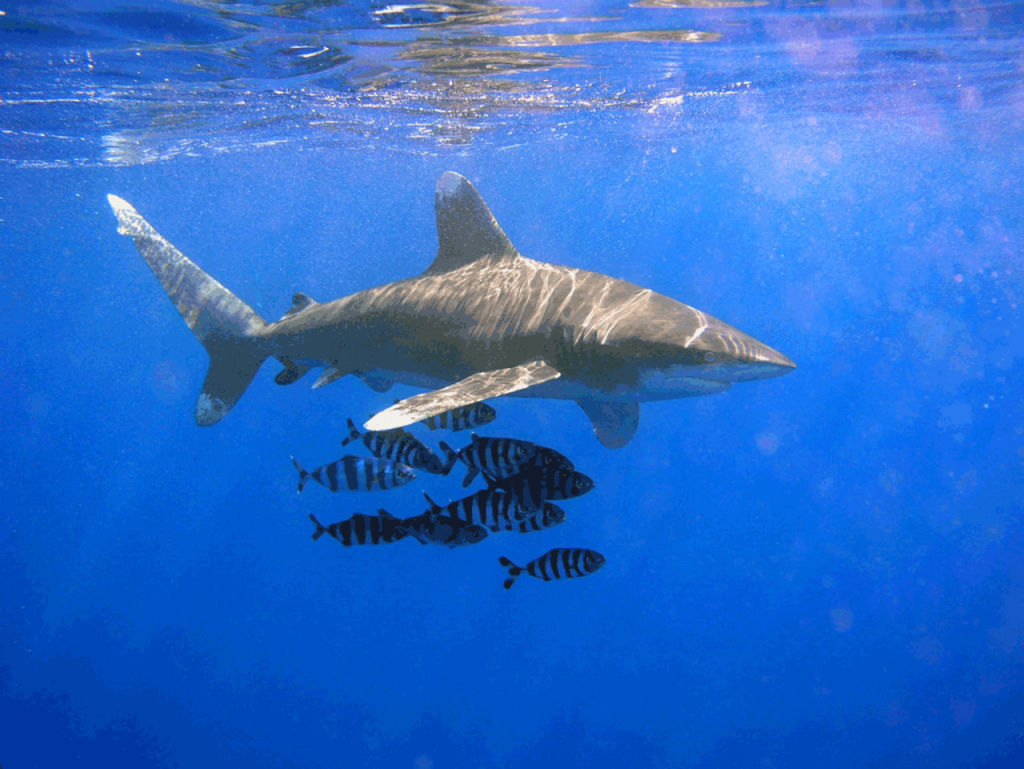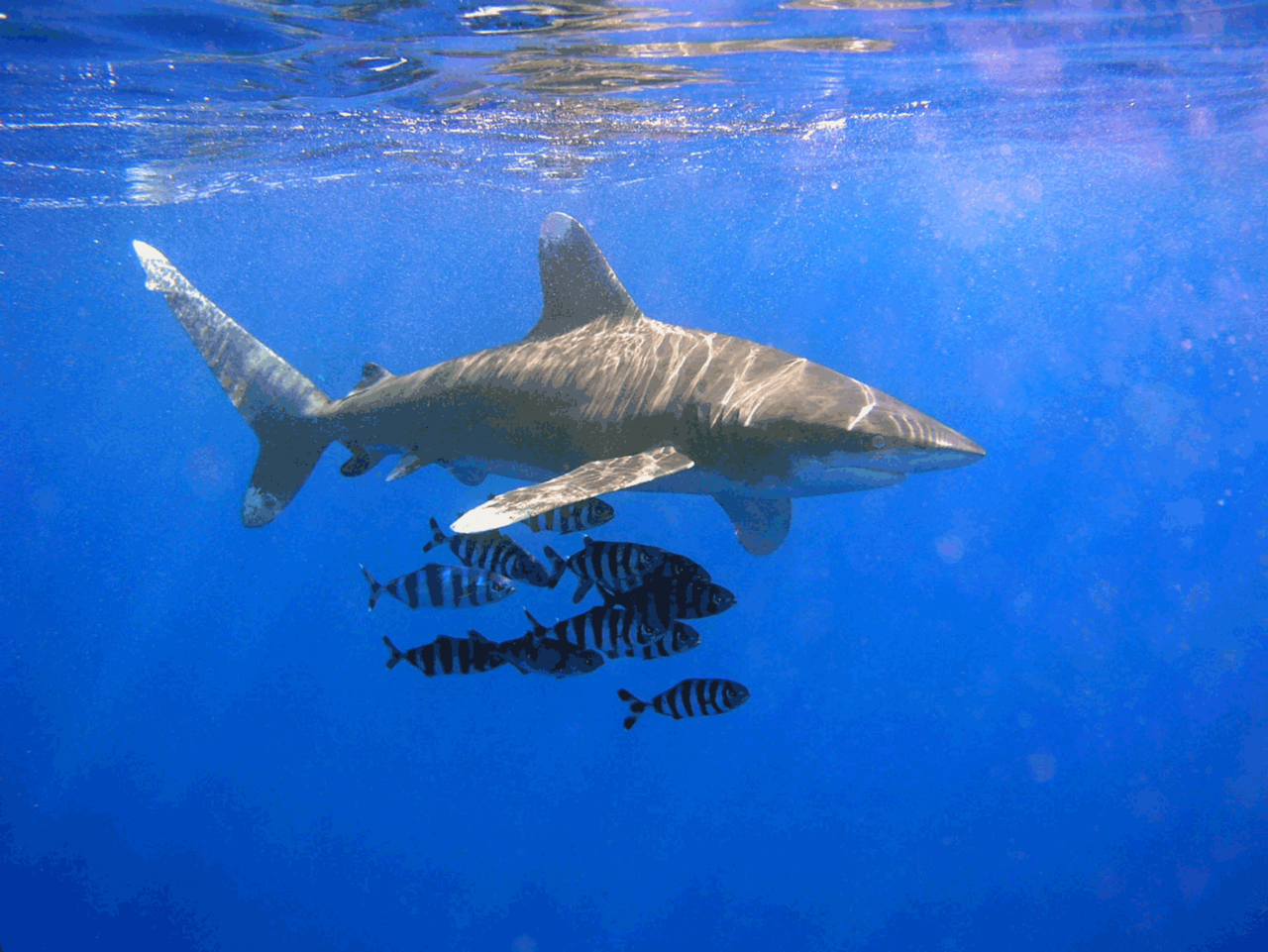
The National Marine Fisheries Service is seeking public comment on a petition from Defenders of Wildlife that seeks to protect oceanic whitetip sharks (Carcharhinus longimanus) under the federal Endangered Species Act.
On January 12, NMFS announced in the Federal Register that it had concluded its initial 90-day review of the petition, finding that the petition “presents substantial scientific or commercial information indicating that the petitioned action may be warranted for the species worldwide.” At the same time, the agency opened up a 60-day comment period, soliciting information on the status of the shark from both the commercial and scientific sectors.
The shark is found in waters of the open ocean throughout the world, including those fished by the Hawai`i longline fleet. Its fins are highly valued, NMFS notes, commanding market prices of between $45 and $85 per kilogram. “In fact, demand from the international fin market is considered to be the primary force driving retention of bycatch of this species, as the meat is considered to be of low commercial value,” NMFS goes on to say. With the oceanic whitetip shark accounting for roughly 3 percent of all shark fins auctioned in Hong Kong, one of the world’s largest fin-trading centers, NMFS says, this means that “approximately 200,000 to 1.3 million oceanic whitetips … may enter the global fin trade each year.”
Even when they are not retained on board after being hooked, Defenders of Wildlife said in its petition, many oceanic whitetips will die. NMFS’ own research, however, determined that these sharks “do have relatively high survivorship in comparison to other shark species when caught on longline gear.” Still, NMFS adds, “we do agree with the petition that … although oceanic whitetips have higher survivorship than some other pelagic shark species, these sources of mortality must also be taken into consideration.”
Since 2011, the catch of oceanic whitetips has been banned by the International Commission for the Conservation of Atlantic Tunas (ICCAT), resulting in a substantial reduction – from 1.1 metric ton caught in 2011 to 0.03 mt in 2013.
But the declining catch is not necessarily a positive sign. As measured by a standard fishing metric, catch per unit effort (CPUE), the oceanic whitetip shark has gone from being the second-most abundant shark in the ICCAT region, as recently as 1997, to low CPUEs in recent years. “Though these data do not indicate whether a decline in the oceanic whitetip population occurred, they clearly show that this species is currently not abundant in this area.” What’s more, a high percentage of the oceanic whitetip sharks caught are juveniles, “which, in combination with significantly low catches and low patchy abundance in areas where the species was formerly abundant, may be indicative of significant fishing pressure leading to population declines.”
In the Pacific Ocean, the situation is no better. A stock assessment conducted in the region under the jurisdiction of the Western and Central Pacific Fisheries Commission (WCPFC) determined that “fishing mortality on oceanic whitetip sharks … has increased to levels 6.5 times what is sustainable.”
Hawai`i’s Role
As recently as 2013, oceanic whitetips accounted for 3 percent of the sharks caught by the Hawai`i longline fleet. But the CPUE of the species has decreased dramatically over a 15-year period: from 0.428 sharks caught per 1,000 hooks in 1995 to less than a tenth of that in 2010: 0.036/1,000 hooks. In addition, the number of longline sets that saw no oceanic whitetips on the lines increased in the same period: from 74.7 percent in 1995 to 95.3 percent in 2010.
When all other factors – sea surface temperature, areas fished, et cetera – are considered, “whitetip CPUE declined by more than 90 percent in the Hawai`i-based longline fishery since 1995,” NFMS has determined.
According to reports compiled by NMFS’ Pacific Islands Fisheries Science Center, in 2014, Hawai`i longline vessels caught 701 oceanic whitetip sharks, with a CPUE of 0.01 per 1,000 hooks.
Up until 2000, when the state of Hawai`i prohibited finning and required shark fins to be landed with their corresponding carcasses, Hawai`i was the source for a large part of the fins exported to Hong Kong. After that, NMFS says, “shark fin imports from the United States into Hong Kong declined significantly (54 percent decrease, from 374 to 171 tonnes) as Hawai`i could no longer be used as a fin trading center for the international fisheries operating and finning in the Central Pacific… However, in other parts of the species’ range, the inadequacy of existing fishing bans may be contributing to further declines in the species by allowing the wasteful practice of shark finning at sea to continue.”
Michael Tosatto, administrator of NMFS’ Pacific Islands Regional Office, based in Honolulu, was asked how the ban on shark-finning was enforced. NMFS’ Office of Law Enforcement “monitors some but not all of the offloads and responds to any reports to enforce our fins-attached rules,” he replied. The Honolulu fish auction “knows that they need fins attached, so they don’t accept anything else,” he went on to say. “They will only dress (remove) fins when they must and as a practice will secure the offal/trash until it is picked up for disposal.”
As for the practice of transshipping fins at sea – transferring them from one boat to another, so as to avoid landing fins where they are banned – Tosatto stated: “Transshipping fins off ahead of landing would be risky, since you’d need a lot of fins to make it worth someone’s time to pick them up. There is always a chance someone is trying to cheat, but I think I would put [the fins-attached rule] at a low threat of violation.
“That said, the international rule for 5 percent by weight is problematic and remains a high threat. When foreign boats offload in U.S. ports, OLE is alert for this.”
The rule Tosatto is referring to here is one adopted by WCPFC in 2010 that says the weight of any detached fins on board a regulated vessel has to be no more than 5 percent of the weight of corresponding shark carcasses.
Other Factors
Aside from the market in shark fins, other factors make oceanic whitetip sharks susceptible to extinction, NMFS notes. Defenders of Wildlife pointed out that the shark’s low reproductive rate (5-6 sharks per litter, with one litter produced every two years), and its relatively long time to mature (four to seven years) make it especially vulnerable to overfishing and impede its ability to recover rapidly.
On this point, NMFS notes that a 2012 assessment of Atlantic sharks ranked oceanic whitetips sixth out of 20 pelagic shark species in terms of its susceptibility to longline gear.
In summarizing its analysis of the suitability of Endangered Species Act protection for the species, NMFS concludes that the petition and other information in NMFS’ own files “do present substantial scientific or commercial information indicating that … ‘overutilization for commercial, recreational, scientific, or educational purposes’ as well as ‘inadequacy of existing regulatory mechanisms’ and ‘other manmade or natural factors’ may be causing or contributing to an increased risk of extinction for the species.”
NMFS has opened a 60-day comment period on the petition through March 14. More information is available on the NMFS PIRO website: http://www.fpir.noaa.gov/
— Patricia Tummons
For Further Reading
The January 2016 issue of Environment Hawai`i reports on shark-finning in the WCPFC:


Leave a Reply